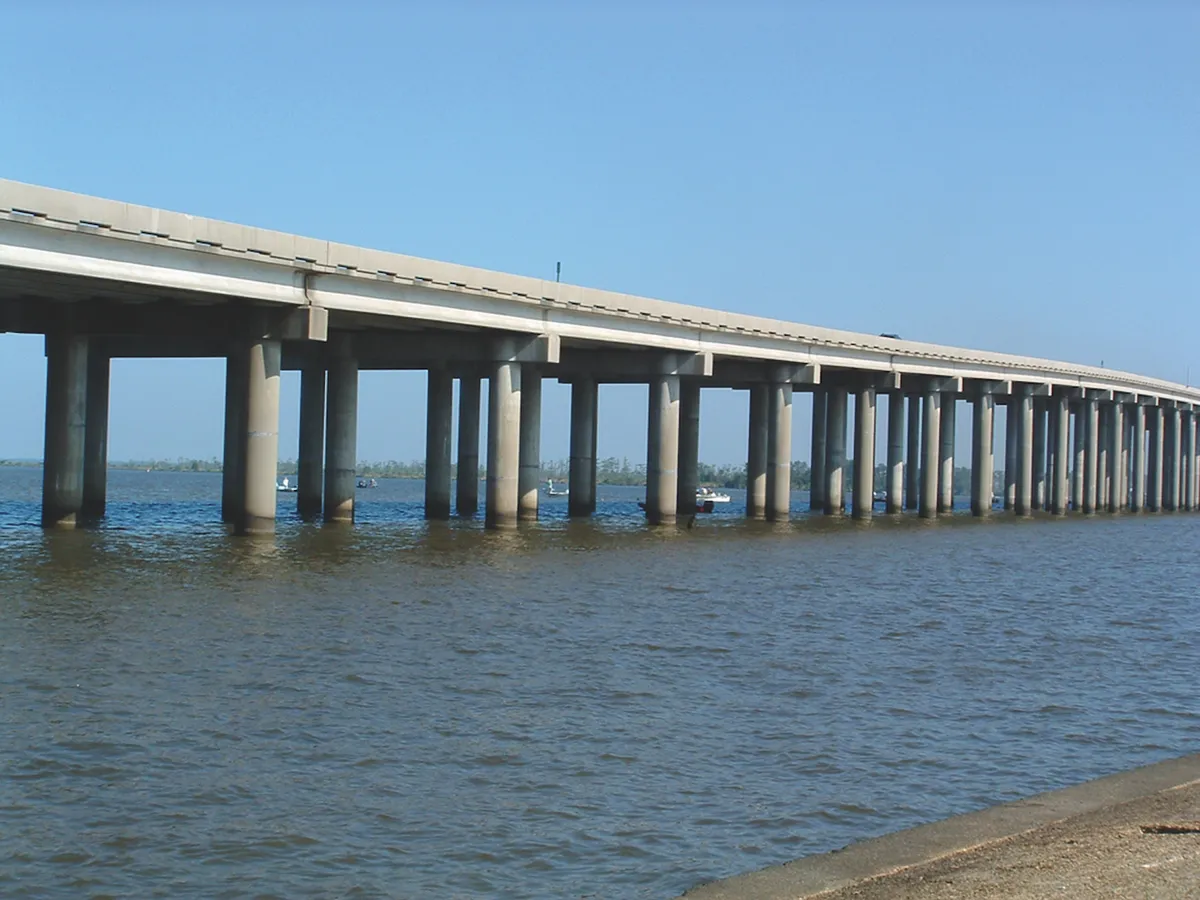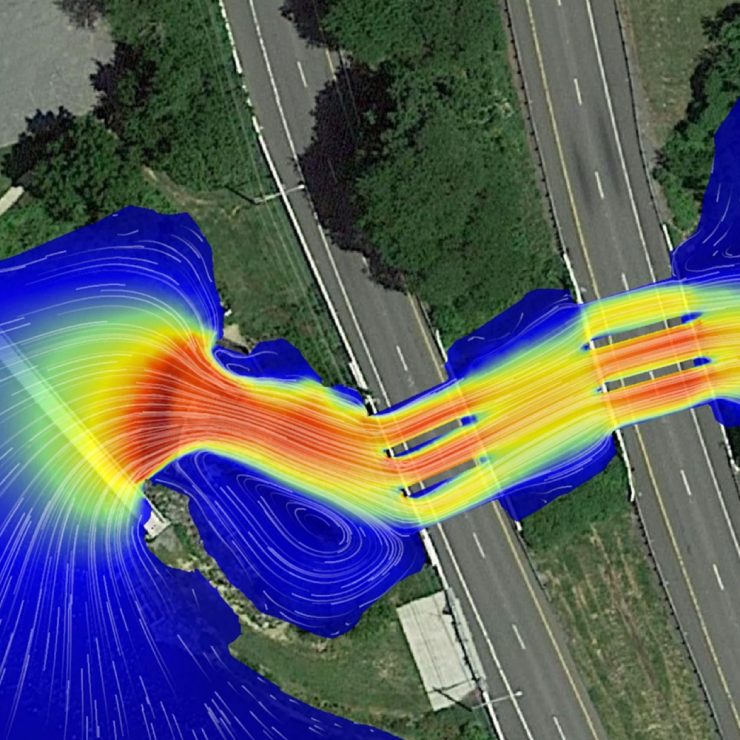A Bridge Inventory and Management System (BIMS) is a comprehensive software solution used by transportation authorities, engineering firms, and infrastructure managers to efficiently manage the inspection, maintenance, and rehabilitation of structures such as bridges, box culverts etc. The primary goal of a BIMS is to ensure the safety, functionality, and longevity of bridge structures while optimizing budget allocation as well as resource utilization. Key features typically found in a Bridge Inventory and Management System (BIMS) include:
- Database Management: A centralized database to store detailed information about each bridge within a network, including construction materials, structural components, historical data, inspection reports, and maintenance records.
- Asset Inventory: A detailed inventory of all bridge assets, including their locations, dimensions, geometrical, structural conditions, and traffic characteristics.
- Condition Assessment: Tools for conducting regular inspections and assessments of bridge conditions, including visual inspections, non-destructive testing, and structural health monitoring.
- Risk Assessment: Analytical tools to assess the risk levels associated with each bridge asset based on factors such as structural integrity, traffic volume, environmental conditions, and historical performance.
- Maintenance Planning: Modules for planning and scheduling routine maintenance activities, such as cleaning, painting, and minor repairs, to ensure optimal performance and longevity of bridge structures.
- Rehabilitation and Replacement Planning: Tools for identifying and prioritizing bridge rehabilitation and replacement projects based on factors such as structural deficiencies, safety risks, and cost-effectiveness.
- Budgeting and Financial Analysis: Features for budget planning, cost estimation, and financial analysis to optimize resource allocation and prioritize investment decisions.
- Performance Monitoring: Metrics and indicators to monitor the performance of bridge assets over time, including deterioration rates, service life projections, and compliance with safety standards.
- Reporting and Documentation: Customizable reporting capabilities to generate comprehensive reports for stakeholders, regulatory agencies, and decision-makers, including inspection findings, maintenance activities, and budgetary allocations.
- BIMS Integration with GIS and Other Systems: Integration with Geographical Information Systems (GIS), asset management systems, and other relevant software platforms to enhance data visualization, analysis, and decision-making processes.
 Overall, a Bridge Management System (BIMS) plays a crucial role in ensuring the safety, reliability, and efficiency of transportation infrastructure networks by providing decision-makers with the tools and insights needed to effectively manage and maintain bridge assets.
Overall, a Bridge Management System (BIMS) plays a crucial role in ensuring the safety, reliability, and efficiency of transportation infrastructure networks by providing decision-makers with the tools and insights needed to effectively manage and maintain bridge assets.
Bridge safety encompasses various aspects to ensure the structural integrity and reliability of bridges, which are crucial for the safety of people and vehicles crossing them. Here are some key aspects of bridge safety:
Structural Integrity: Bridges must be designed and constructed to withstand various loads, including the weight of vehicles, environmental forces such as wind and earthquakes, and other factors. Regular inspections and maintenance are essential to ensure that the structure remains sound over time.
Material Quality: The materials used in bridge construction, such as steel, concrete, and cables, must meet stringent quality standards to ensure durability and resistance to corrosion and fatigue.
Design Standards: Bridge design must adhere to established engineering standards and codes to ensure safety and reliability. These standards cover aspects such as load capacities, geometry, and construction techniques.
Regular Inspections: Periodic inspections are necessary to detect any signs of structural damage, deterioration, or other safety concerns. Inspections may include visual assessments, non-destructive testing, and monitoring of structural behavior.
Maintenance and Repair: Prompt maintenance and repair of any defects or damage are essential to prevent further deterioration and ensure the continued safety of the bridge. This may involve tasks such as repainting, replacing corroded elements, or repairing cracks.
Emergency Preparedness: Bridges should have emergency response plans in place to address potential hazards such as accidents, natural disasters, or acts of terrorism. These plans may include procedures for evacuating the bridge, temporary repairs, or coordinating with emergency services.
Load Limits and Restrictions: Bridges have designated load limits to prevent overloading, which can compromise their structural integrity. Weight restrictions may be imposed on certain vehicles or types of cargo to ensure safe passage.
BIMS – Structural Analysis and Assessment
In most cases, visual inspection often result in large amounts of data stored in the BIMS inventory that serve as input for image-based processes for defect and damage detection. While traditional method for simply relied on human evaluation, Computer Vision techniques taking advantage of Artificial Intelligence and Machine Learning semi-automatize the extraction of meaningful information from pictures taken during inspections. For instance, recent applications of semantic segmentation allows the identification of elements affected by corrosion or other degradation phenomena, enabling experts to assign a grade of severity for the damage. Additional insights on the structure conditions are given by numerical simulations on fatigue behavior with finite element method modeling. This case is particularly valuable when data from in-depth detailed inspections or load tests are available, providing a rich information inventory also for computing simulations on stress behaviors and mechanics.
In BIMS, bridge structural analysis and assessment are critical processes in ensuring the safety, reliability, and longevity of bridges. Here’s an overview of the key steps involved:
Load Analysis: The first step in bridge structural analysis is to determine the loads that the bridge will be subjected to during its service life. These loads include dead loads (self-weight of the bridge), live loads (traffic loads), environmental loads (such as wind, seismic, and temperature effects), and other factors. Load combinations are then applied based on design codes and standards to assess the structural response under various conditions.
Structural Modeling: Bridge structures are typically complex, and accurate modeling is essential for analyzing their behavior. Various software tools are available for creating detailed finite element models of bridges, considering factors such as geometry, materials, supports, and loadings. Advanced modeling techniques may be used to capture nonlinear behavior, dynamic effects, and other factors.
 Static Analysis: Static analysis involves applying loads to the bridge model and calculating the resulting internal forces, stresses, and deformations. This analysis helps engineers evaluate the overall stability and strength of the bridge under normal operating conditions.
Static Analysis: Static analysis involves applying loads to the bridge model and calculating the resulting internal forces, stresses, and deformations. This analysis helps engineers evaluate the overall stability and strength of the bridge under normal operating conditions.
Dynamic Analysis: Dynamic analysis is performed to assess the bridge’s response to dynamic loads, such as traffic-induced vibrations, wind gusts, or seismic events. Techniques such as modal analysis, time-history analysis, and spectral analysis may be used to predict the dynamic behavior and identify potential resonance effects or critical frequencies.
Structural Assessment: In BIMS, once the structural analysis is complete, engineers assess the bridge’s performance against design criteria and safety standards. This assessment includes checking for compliance with load capacity requirements, deflection limits, stress concentrations, and other performance indicators.
Condition Evaluation: Regular inspections and condition assessments are essential for monitoring the health of bridges over time. Visual inspections, non-destructive testing (NDT), and structural health monitoring (SHM) techniques may be used to detect defects, deterioration, or damage, such as corrosion, cracking, or deformation.
Risk Assessment: Risk assessment involves evaluating the likelihood and consequences of potential failure modes and hazards associated with the bridge. This analysis considers factors such as traffic volume, bridge condition, environmental conditions, and consequences of failure to prioritize maintenance and rehabilitation efforts.
Maintenance and Rehabilitation Planning: Based on the findings of structural analysis and assessment, maintenance and rehabilitation strategies are developed to address any identified deficiencies or risks. This may involve activities such as repairing damaged components, strengthening structural elements, or implementing preventive maintenance measures.
Lifecycle Management: Effective bridge management requires a comprehensive approach that considers the entire lifecycle of the structure, from design and construction to operation and maintenance. Asset management principles are applied to optimize investment decisions, prioritize resources, and ensure the long-term sustainability of bridge infrastructure.
BIMS – Geometric Analysis and Assessment
Bridge geometric information typically refers to the structural layout, dimensions, and shapes involved in the bridge’s design and construction. Geometric aspects of bridges entail the following:
Span: The distance between two supports of a bridge. This can vary widely depending on the type of bridge, ranging from short spans in pedestrian bridges to long spans in major highway or railway bridges.
Width: The horizontal distance between the two sides of the bridge, often measured as the width of the roadway or deck.
Height: The vertical distance from the base of the bridge to its highest point, such as the top of an arch or the highest point of a suspension bridge’s towers.
Alignment: The straightness or curvature of the bridge’s path. Bridges can be straight, curved, or have complex alignments to navigate challenging terrain.
Deck Profile: The cross-sectional shape of the bridge deck, which can vary based on factors like the bridge’s function, aesthetics, and structural requirements.
Clearance: The minimum vertical distance between the bridge deck and any obstacles below, such as waterways or roads passing beneath the bridge.
Superstructure: The part of the bridge that supports the roadway or railway, including beams, girders, arches, or cables in the case of suspension or cable-stayed bridges.
Substructure: The underlying support structure of the bridge, including abutments, piers, or foundation systems that transfer loads from the superstructure to the ground.
Geometry of Components: The shapes and dimensions of various structural elements such as beams, columns, trusses, and cables that make up the bridge.
Slope and Grade: The incline or decline of the roadway or deck, often expressed as a percentage or gradient.
Transition Curves: Curves used to gradually transition from straight to curved alignments or to ease the transition between different superelevation (banking) levels.
Skew: The angle between the centerline of the bridge and its supports, which can affect the bridge’s appearance, construction complexity, and structural behavior.
Hydrological Analysis and Assessment
Hydrological analysis and assessment are essential steps in the design, construction, and maintenance of bridges, especially those spanning water bodies such as rivers, streams, or estuaries. Hydrological bridge analysis focuses on:
Gathering Hydrological Data: Engineers begin by collecting data on the hydrological characteristics of the site, including historical flood records, streamflow data, rainfall patterns, topographic maps, and geological surveys. This data helps in understanding the natural variability of water flow and potential flood events in the area.
Hydraulic Modeling: Engineers use hydraulic modeling software to simulate water flow conditions under various scenarios, including normal flow, flood events, and extreme weather conditions. These models take into account factors such as channel geometry, flow rates, water levels, and potential obstructions to flow.
Flood Frequency Analysis: Engineers perform statistical analysis to determine the frequency and magnitude of potential flood events, such as the 100-year flood or the 500-year flood. This information is crucial for designing bridges to withstand the expected hydrological loads over their design life.
 Scour Analysis: Scour, or the erosion of sediment around bridge foundations due to flowing water, is a significant concern for bridge safety. Engineers conduct scour analysis to assess the risk of foundation undermining and determine appropriate measures to mitigate scour, such as riprap placement, scour aprons, or deeper foundations.
Scour Analysis: Scour, or the erosion of sediment around bridge foundations due to flowing water, is a significant concern for bridge safety. Engineers conduct scour analysis to assess the risk of foundation undermining and determine appropriate measures to mitigate scour, such as riprap placement, scour aprons, or deeper foundations.
Bridge Hydraulic Design: Based on the hydrological and hydraulic analysis, engineers design the bridge’s hydraulic features, including the size and shape of bridge openings, culverts, and floodplain conveyance structures. The goal is to ensure that the bridge can safely pass expected water flows without causing excessive backwater or upstream flooding.
Sizing of Hydraulic Structures: Hydraulic structures such as culverts, weirs, or floodgates are sized to accommodate the anticipated flow rates and prevent overtopping or failure during flood events. This involves considering factors such as velocity, flow capacity, sediment transport, and debris accumulation.
Environmental Considerations: Hydrological analysis also takes into account environmental factors such as habitat protection, water quality, and ecological connectivity. Engineers work to minimize the impact of bridge construction and operation on aquatic ecosystems while ensuring the safe passage of water and sediment.
BIMS manages and disseminates the Local Roads Bridge Information. This is an integrated information platform of local roads motorable bridges. Local level authority, central level authority, design consultant, contractors are responsible for use and update the information in the system.
Bridge Construction 3D Animation with Details >>> https://www.youtube.com/watch?v=-zC2KzBqD4k












